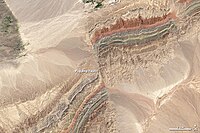
Photo from wikipedia
The transpressional Alpine Fault in New Zealand has created a thick shear zone with associated highly anisotropic rocks. Low seismic velocity zones (LVZ) and high seismic reflectivity are recorded in… Click to show full abstract
The transpressional Alpine Fault in New Zealand has created a thick shear zone with associated highly anisotropic rocks. Low seismic velocity zones (LVZ) and high seismic reflectivity are recorded in the Alpine Fault Zone, but no study has explored the underlying physical rock parameters of the shallow crust that control these observations. Protomylonites are the volumetrically dominant lithology of the fault zone. Here we combine experimental measurements of P‐wave speeds with numerical models of elastic wave anisotropy of protomylonite samples to explore how the fault zone can be seismically imaged. Numerical models that account for the porosity‐free real samples' fabric elastic tensors from EBSD are calculated by MTEX and a finite element model (FEM), while microfractures are modeled with differential effective media (DEM) theory. At effective pressures representative of the Alpine Fault brittle zone, experimental wave speeds are lower than those predicted by MTEX/FEM. A possible DEM model suggests that a combination of random and aligned microfractures with aspect ratios increasing with pressure can explain the experimental wave speeds for pressures <70 MPa. Such micro‐porosity in the form of foliation‐ and mica basal plane‐ parallel microfractures and grain boundaries is validated with synchrotron X‐ray microtomography and TEM images. Finally, by modeling anisotropy of seismic reflection coefficients with angle of incidence, we demonstrate that the high reflectivity and LVZ observed at the Alpine Fault can only be explained if this microporosity is accounted for throughout the brittle fault zone, even at depths of 7‐10 km.
Journal Title: Journal of Geophysical Research
Year Published: 2020
Link to full text (if available)
Share on Social Media: Sign Up to like & get
recommendations!